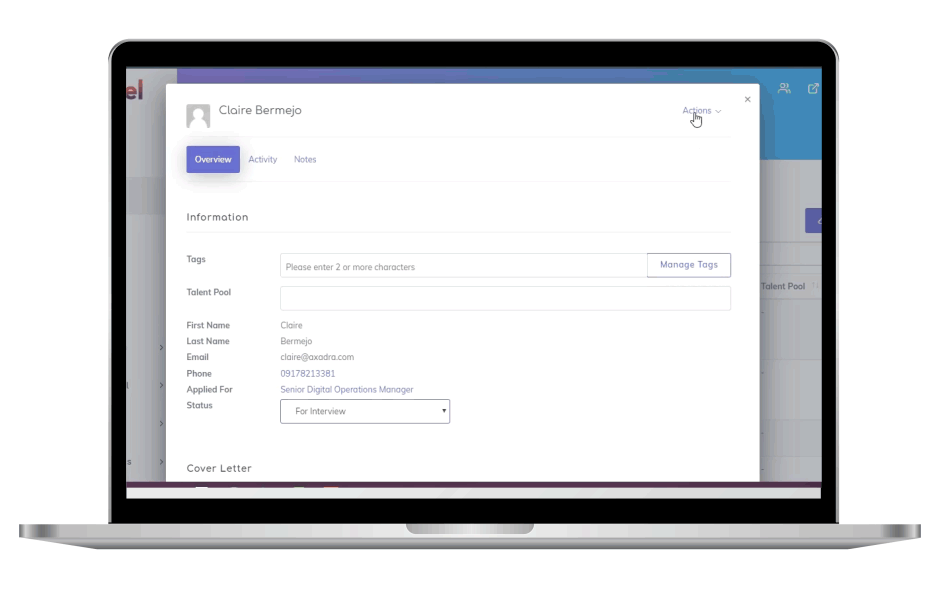As a recruitment professional, having many applicants for your organization is a good thing. This means that your job postings and advertisements are reaching your target audience. You also have more chances of screening and talking to qualified individuals who can be good additions to your team, which you can increase further with lean hiring.
Screening various candidates is not always easy. Reading through several CVs and interviewing many applicants can become too tedious. This is especially true if you have limited access to resources, such as manpower and recruitment automation.
Being required to find and hire a qualified professional under time constraints can also make your job harder. As a part of the company, you know that any delay in filling open job positions can cause your organization to lose productivity and revenue.
Dealing with this kind of pressure can cause any recruiter to experience stress. When this happens, your job performance might be affected, causing you to become purely mechanical in what you do. This can lead to poor outcomes that can affect the company.
To help your recruitment team avoid stress and burnout, you need a more efficient and effective recruitment process. One way you can achieve this is through the lean methodology.
What is Lean Recruitment?
Lean recruitment is a type of hiring process where the lean methodology that originated from the manufacturing industry is applied. This approach consists of a variety of tactics aimed at improving the recruitment process by making it more efficient for both the candidate and the hiring professional.
The lean recruitment process uses a proactive approach to hiring to maintain a pool of qualified potential applicants to consider when a position opens in the company. With a steady supply of qualified candidates, HR doesn’t need to start from scratch looking for new candidates whenever a position becomes available.
In doing so, lean recruitment helps to reduce the costs and waste associated with the hiring process. By emphasizing efficiency, this process helps minimize errors, delays, and costs while allowing HR departments to deliver better results.
What is Waste in Recruitment?
It might not be apparent, but manufacturing and recruitment are similar processes, which is why the lean process that originated in manufacturing also works well in hiring. Both aim to supply a demand through a systematic process. The more efficient the supplying process is, the better the outcome for the user or party is. In the context of recruitment, this end-user refers to the organization hiring a new employee.
Waste refers to any resource or effort expended that doesn’t add value to an organization. For a supply and demand process, such as recruitment, producing waste is inevitable. Some of the kinds of waste generated by the hiring process include the following:
Time
The recruitment process has multiple stages, some of which take up a lot of time. For one, combing through resumes takes a long time, as does interviewing candidates.
If, after spending a lot of time on the process, you did not find the right match for the position, the time you spent is considered waste. You’ll need to spend additional hours finding the right person to hire.
Ineffective Sources
To make it easier to find and attract applicants, HR departments may pay for sourcing platforms and software.
But if the sourcing platforms cannot offer quality candidates, the resources used to use them become waste. In lean hiring, sources used should help make the recruitment process faster and more efficient.
Delays
As a recruiter, you should know how important it is to contact promising applicants as often and as soon as possible. Doing so allows you to reassure candidates that they are still being considered for the role.
However, the process may involve one too many steps or the recruiter may struggle with scheduling interviews, causing delays. Any delays in the recruitment process are considered a form of waste since that time could have been used to move the onboarding along and get the candidate working.
More importantly, if you delay contacting an applicant, they might lose interest in the job and move on to other companies.
Overprocessing
Overprocessing candidates before deciding is another form of waste in recruitment. While recruiters are expected to process resumes and interview prospects to filter them and find the best hire for the company, some may go overboard. Some companies may ask candidates to go through multiple rounds of interviews asking the same questions repeatedly.
Overprocessing adds unnecessary time and effort for all involved, making it waste.
Defects
Hiring a candidate that’s not the best match for the company or position is one of the most straightforward types of waste in lean recruiting. When the wrong choice is made, all the efforts exerted – from recruitment to onboarding to training – are wasted as you need to start the process all over again.
Many recruiters try to avoid this as much as possible through overprocessing, but lean recruitment requires efficiency and minimal errors.
How the Lean Recruitment Process Reduces Waste
The lean recruitment process has its roots in manufacturing. It was originally called Just in Time (JIT) production by Toyota. Simply put, this concept encourages business owners and officials to remove any unnecessary activity, product, or service that does not add value for the customer. The process requires streamlining not only the processes but also how much raw materials and inventory are needed at any given time.
In recruitment, this translates to a proactive approach that allows companies to streamline their processes and save time and resources.
The goal of lean recruitment is to reduce the steps and efforts required to hire a qualified candidate. Instead of having to gather a new pool of potential candidates each time there is a job opening, lean recruitment encourages the recruiter to maintain a talent pipeline from which to select their candidates.
With a talent pipeline, you maintain a pool of talent. You keep the contact details and resumes and maintain relationships with potential candidates who may have previously connected with you in some way.
That way, when the need arises, you have access to contact information and resume of qualified prospects. This means that you do not have to scramble to make job ads, source new candidates, and go through hundreds of resumes every time your organization has an opening. You can simply select the best candidates from your inventory and proceed to interview them for the available position.
With this process, you reduce the time and resources needed to accomplish the first steps in the recruitment process, thereby giving you more time to decide while still reducing the amount of time needed to hire.
The JIT approach works best if you have already established a pipeline that will provide you with an expansive list of highly qualified candidates. As such, it doesn’t always work. Creating a pipeline for every job type in your company is hard, if not impossible. When you need to fill in a position that you do not have a pipeline for, you need to source applicants the old-fashioned way.
Reducing Waste in Remote Settings
Lean hiring offers numerous benefits for companies that operate in remote work set-ups. Remote companies face unique challenges in hiring that may result in waste.
While they can hire employees from any location, they may struggle to find quality applicants or be overwhelmed by the sheer number of applicants. Recruiters may also struggle with navigating time zones when scheduling interviews. Furthermore, some recruiters may feel the need to add more steps to vet a candidate’s qualifications.
All these may result in waste in the recruitment process.
With lean recruitment, remote companies can reduce expenditure on recruitment and still ensure that they hire the right candidate. The lean methodology doesn’t require companies to follow one process. Rather, it encourages them to evaluate their current process and remove any unnecessary steps.
The result is a simplified process that ensures both your and your candidates’ time and resources are used wisely.
Thus, a remote company may consolidate its sourcing process by using only one free recruitment CRM software that also functions as an interview scheduler and applicant tracker. They may also optimize their criteria for candidates to interview, as well as their test and interview questions.
It’s easy to get lost in the process when recruiting remotely. The lean methodology can help remote companies keep their recruitment process streamlined and continue improving it.
History of Lean Hiring
The term “lean” was first used in the manufacturing industry and made famous by Toyota. Lean manufacturing is a type of supply chain technique that was created to reduce costs incurred and waste created during production. It also aims to help the company create better outcomes for their products and employees.
The lean methodology follows six main principles. Following these will help any individual or organization in experiencing the benefits provided by this approach:
- Continuous improvement
- Respect for people
- Long-term principles
- The right to produce the right results
- Adding value to the organization by developing people and partners
- Continuously solving root problems and driving organizational learning
Based on the principles listed above, it is evident that the lean methodology focuses on the people involved in the processes instead of the pieces of equipment needed or the output. This approach aims to empower individuals to become more proactive in improving their workflows and learning from their mistakes. Through this technique, employees are more inspired to do better at their jobs.
The lean methodology can also be more sustainable for companies in the long run. Because this approach encourages individuals to strive to learn and better themselves, organizations do not need to spend as much money on seminars and training. Companies can also avoid additional costs due to mistakes committed during production.
Implement Lean Methodology in HR Processes
There are various ways that you can use the lean methodology in the recruitment process. Here are some lean recruitment tips you can start with:
Optimize Your Process
Look at your candidate journey map and determine which steps provide the most value to your recruitment process and which ones don’t or tend to be time-consuming. Evaluate which steps you can remove, and which ones simply need to be optimized.
Focus your resources on the most value-adding steps. For example, you may consider establishing your criteria as we suggested in our guide on how to shortlist candidates so your recruitment team can screen candidates faster. In doing so, you allow them to expend more of their resources on interviewing the top choices.
Automate Tasks
The recruitment process involves tasks that are time-consuming and can become repetitive over time. To make hiring more efficient, automate these tedious and time-consuming responsibilities to free up more time for your team.
One of the ways you can achieve this is by using a social recruiting software that will allow you to reach applicants where they spend most of their time—social media platforms. With this software, you can automatically send emails, schedule interviews, and complete other tasks when you make contact with a candidate.
Launch Referral Programs
One of the main elements of lean hiring is a talent pool that recruiters can tap whenever they need to fill a job opening. One of the most efficient ways to maintain a talent pool is through your existing employees’ network.
Statistics show that candidates referred by existing employees are often a better fit for the company and thus, do better at their jobs than non-referred ones.
Make sure to leverage your network by incentivizing employees whenever they make a referral. Then, use the information they have provided in preparing your pipelines for a more effective JIT recruitment.
To make the process more efficient, use a referral recruitment software. This tool allows you to easily keep track of referred candidates and manage the incentives given to employees who made a referral.
Make Use of Your Data
To successfully implement lean hiring in your organization, you need to prioritize learning and continuous improvement. Data plays a crucial role in helping organizations improve their recruitment process.
Data can help you evaluate your processes and determine where you need to improve. For example, analyze the effectiveness of your sourcing platform or if any steps you take is redundant.
Similarly, you can analyze the data you have to determine any recruitment trends and cycles in the organization and use this to inform your recruitment efforts. This will help you plan how and when to use your resources, so it adds the most value to the company.
Talk to Your Team
The best way to make the recruitment process more efficient is to come up with a uniform process that your team can follow whenever they interact with a new hire. You can accomplish this by setting up a meeting with them and discussing the best approach that suits your organization.
While data provides an objective view of your hiring process, it cannot give a complete picture. Ask your team about their experience with the current hiring process – whether they have difficulty with any step, what works or doesn’t work, or have a suggestion for improvement.
By encouraging the team to look for ways to improve work and reduce waste in the process, you get information from the ground that will help you make positive changes.
Get Started with Lean Recruitment Today
Almost, if not all, companies aim to reduce waste as much as possible to conserve time, effort, and resources. This applies to the hiring process as well. Luckily, with lean recruitment, you can ensure an efficient way of filling in vacant positions in your company while also reducing waste.
Implement lean recruitment process for your company today and experience its benefits. For more information, get in touch with us.




















